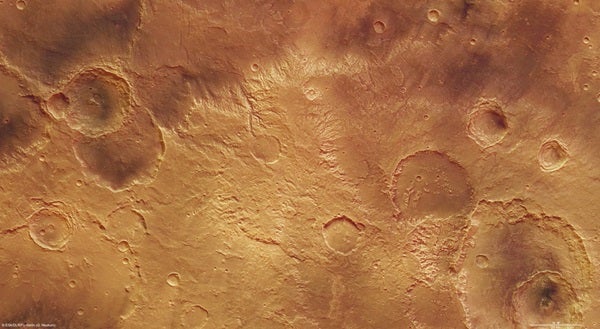The Mars Express High Resolution Stereo Camera has imaged craters both young and old in this view of the Southern Highlands of Mars.
Part of the Sirenum Fossae region in the Southern Highlands, the area in this image is centered at about 28° South, 185° East. The image captures an area to the north of the Magelhaens Crater. It extends about 143 miles by 79 miles (230 kilometers by 127 kilometers) and covers about 11,370 square miles (29,450 square kilometers), roughly the size of Belgium. The image resolution is approximately 95 feet (29 meters) per pixel.
Sirenum Fossae extends for more than 1,550 miles (2,500 kilometers) to the southwest of the Tharsis volcanic region, which contains Olympus Mons, the highest volcano in our solar system. Sirenum Fossae is a system of grabens, formed by stresses placed on the crust during the uprising of the Tharsis region. A graben is visible as two sets of parallel lines running from top to bottom to the left of center.
The Southern Highlands are older than the Northern Lowlands, based on the larger number of impact craters seen to cover the region. Craters of 30 miles (50 kilometers) in diameter are common in this area, and they have usually suffered from erosion, indicating they were formed during ancient times.
There is an impact crater with a diameter of about 17 miles (28 kilometers) to the left of the image. In contrast to other craters in its vicinity, it has experienced less erosion — its crater rim and central peak are still preserved. There are three other craters nearby: to the west is a large crater with a diameter of 35 miles (56 kilometers), to the northeast one that stretches 21 miles (34 kilometers) across, and a smaller crater of only 6 miles (9 kilometers) in diameter to the south.
On the basis of their appearances, the craters can be placed in age order. The largest two are the oldest because they have been partially destroyed by the mid-sized crater. The smallest is the youngest because it has impacted into the rim of the mid-sized crater.
In the central part of the image, a plateau is recognizable and shows evidence of further erosion. In particular, there is a broad valley system on the western slope.










